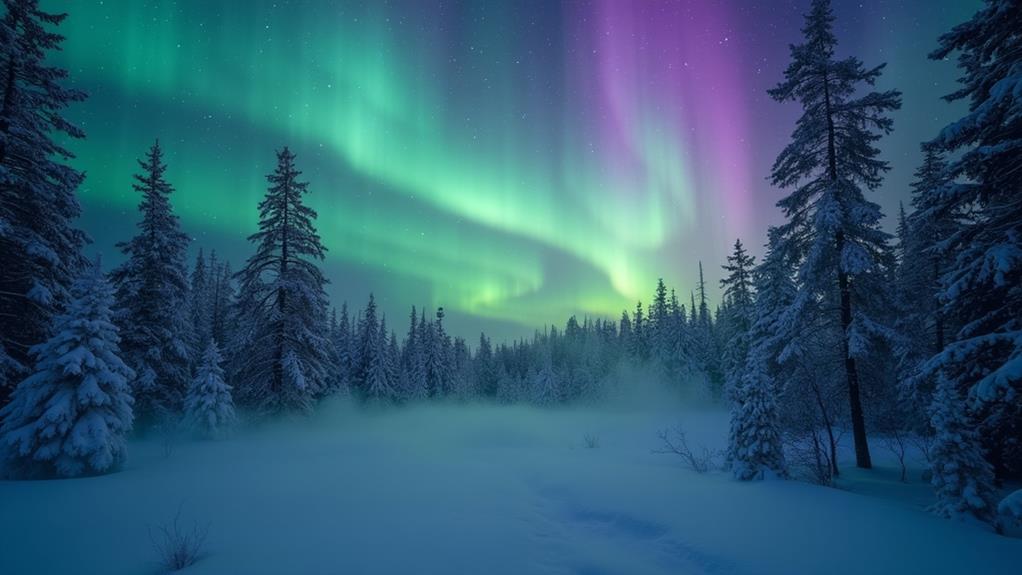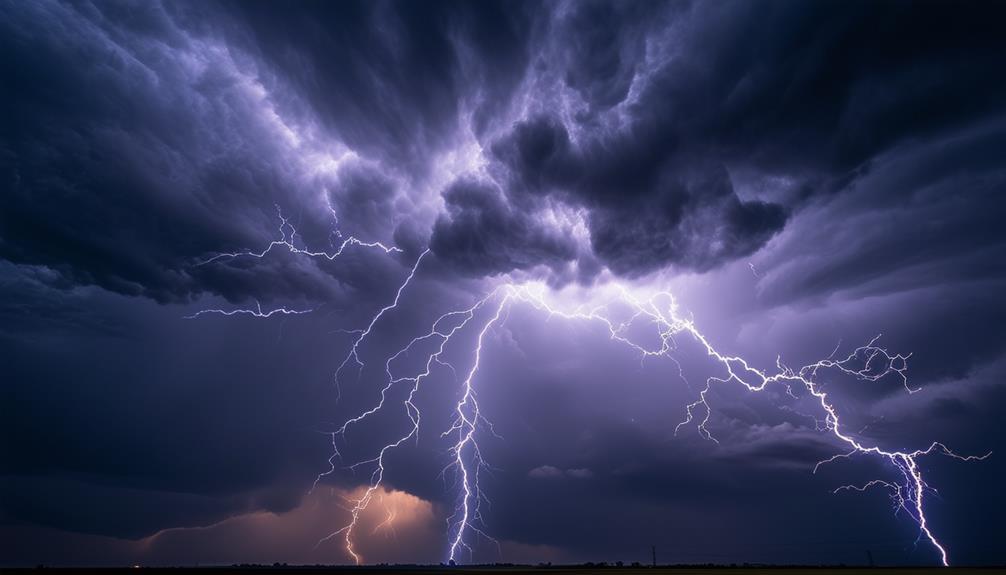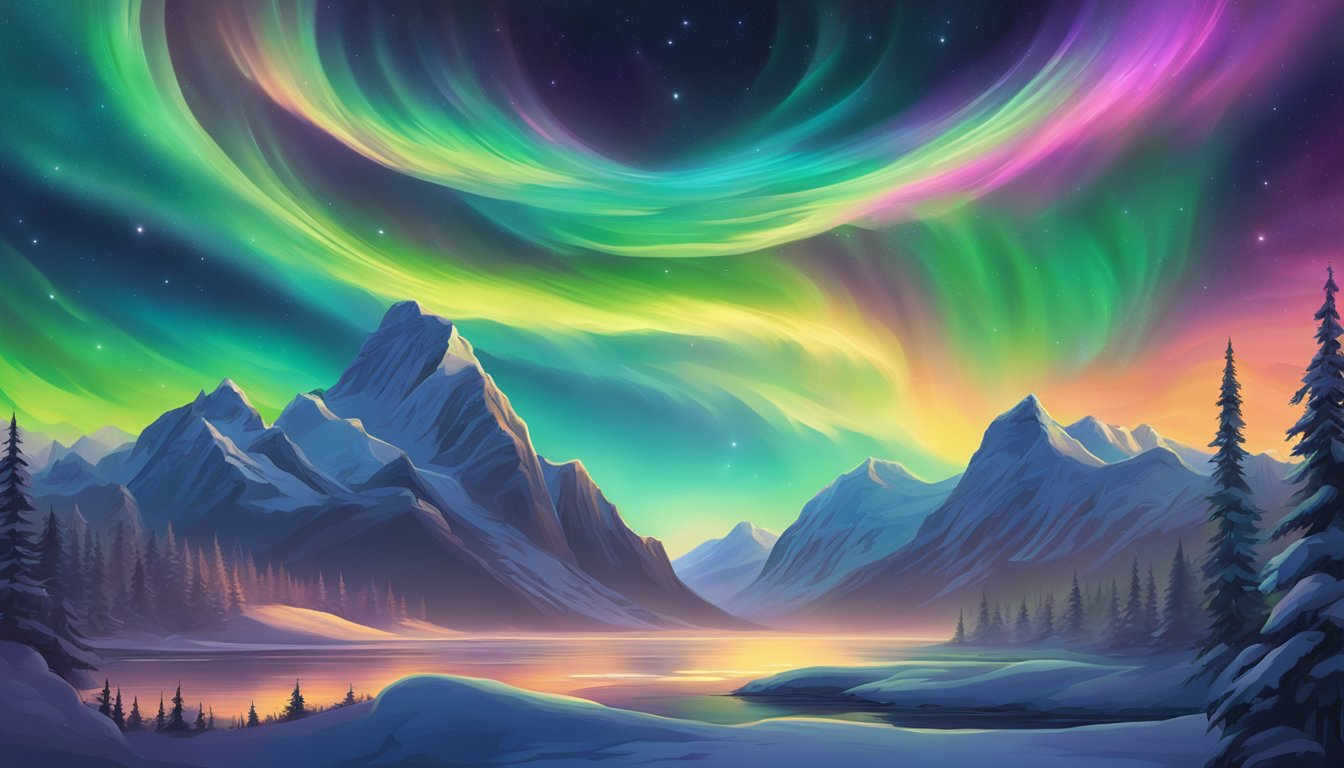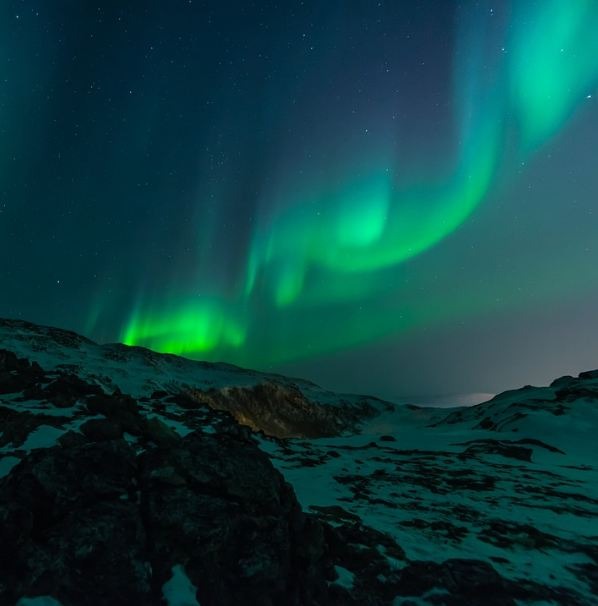Exploring the Different Shapes and Patterns of the Aurora Borealis
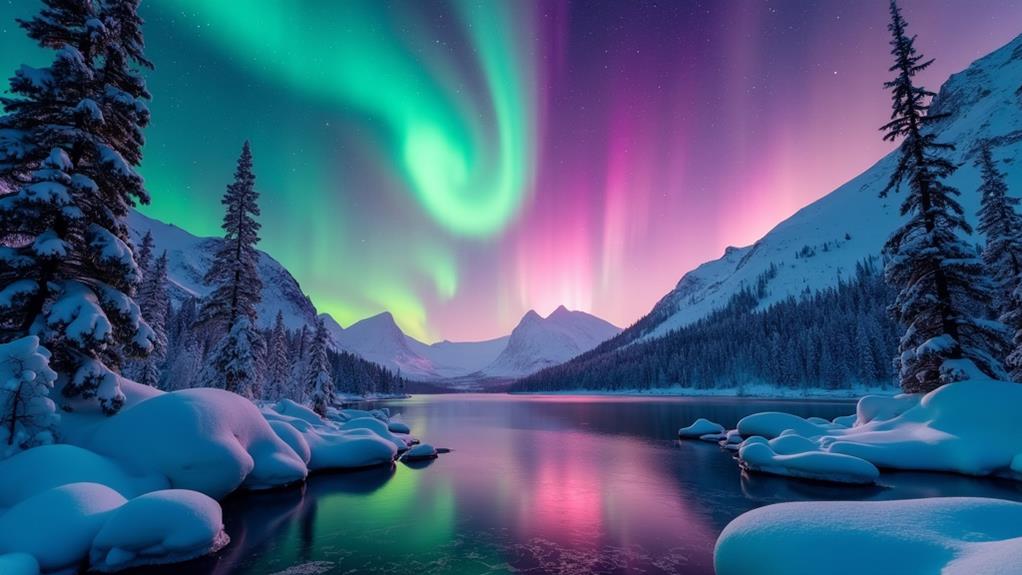
Exploring the different shapes and patterns of the Aurora Borealis reveals a captivating array of natural phenomena. Picture the delicate green arcs stretching across the sky or the stunning curtains of light that seem to dance effortlessly. Each display, with its vibrant colors and dynamic forms, tells the story of solar particles interacting with atmospheric gases. The mystery of how these mesmerizing aurora rays and corona come to life is compelling. Interested in the science behind this celestial ballet and tips for viewing it? There's much more to discover.
Aurora Arc
When observing the Aurora Borealis, you may encounter the captivating aurora arc. This distinctive feature of the Northern Lights often appears as a green band stretching from east to west along the northern horizon. The aurora arc forms due to solar wind activity releasing energy into Earth's atmosphere, influencing the specific shapes and colors seen during auroral displays.
Under low solar activity, the aurora arc may appear grey. However, as activity increases, it transforms into a vibrant green display, mesmerizing all who witness it. The arc is not static; it can be accompanied by rippling or flickering lights that enhance its visual appeal and create dynamic shapes in the night sky.
For the best viewing experience, seek locations with minimal light pollution, allowing clearer visibility of the aurora arc's stunning features. Whether you're in Alaska, Norway, or other prime viewing locations, the beauty and energy of these auroral displays make the effort worthwhile. Remember, the Northern Lights are nature's grand show, and the aurora arc is one of its most enchanting acts.
Aurora Curtains
Among the many wonders of the Aurora Borealis, the enchanting aurora curtains, also known as draperies, captivate onlookers with their billowing, flowing appearance across the night sky. These curtains, characterized by their soft, undulating shapes, display a stunning array of colors, including green, pink, yellow, and purple. The colors are influenced by the type of gas interacting with incoming solar particles and atmospheric conditions.
To fully appreciate the visual effects of aurora curtains, seek out locations with minimal light pollution. These natural light shows are most prominent during periods of heightened auroral activity, especially when solar winds are strong. The slow undulation of these curtains creates a fascinating, almost hypnotic experience.
| Aspect | Details |
|---|---|
| Best Viewing Period | September to April |
| Key Colors | Green, Pink, Yellow, Purple |
| Optimal Conditions | Minimal Light Pollution, Clear Sky |
| Recommendation | Warm Clothing |
When planning your viewing, consider these fundamental observing conditions for an optimal experience. The combination of strong solar winds and clear, dark skies promises a memorable encounter with these awe-inspiring aurora curtains.
Aurora Diffuse
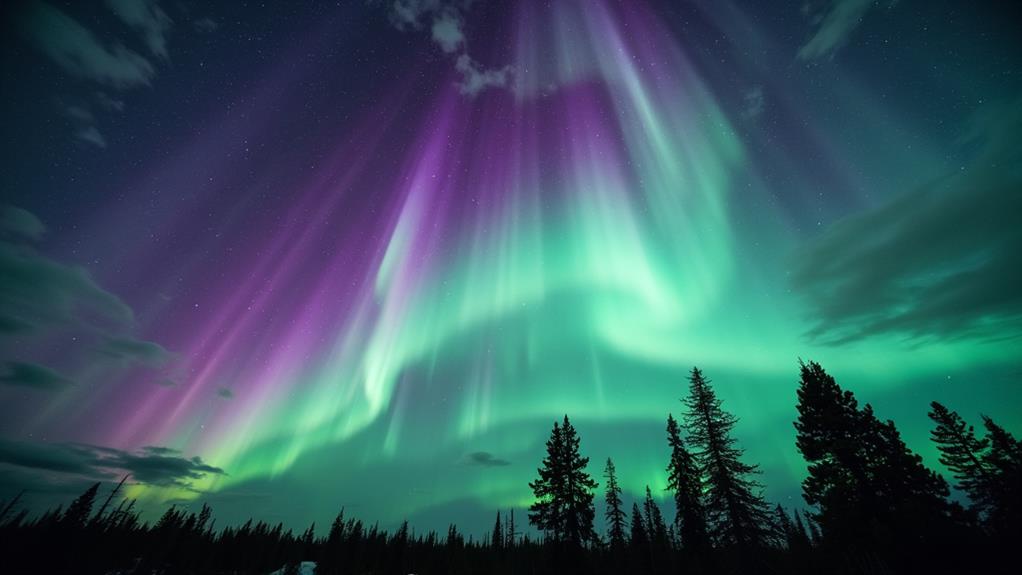
Aurora diffuse, often overlooked yet equally enchanting, manifests as a uniform glow that transforms the night sky into a serene canvas. Unlike the more dynamic auroral displays, aurora diffuse resembles a green fog, lacking distinct shapes and patterns. This form typically appears at higher altitudes and ranges in color from grey to green, depending on the level of solar activity and the energy of the colliding particles.
When solar particles collide with Earth's atmosphere, they sometimes experience fewer collisions, resulting in the consistent appearance of diffuse auroras. This uniform glow contrasts sharply with the rippling and flickering effects commonly associated with other auroral forms. The serene, consistent light offers a different, yet similarly captivating, viewing experience.
To fully appreciate diffuse auroras, seek out areas with minimal light pollution. The darker the surroundings, the more pronounced this uniform glow becomes. Watching a diffuse aurora can feel almost meditative, as the lack of dramatic movement allows you to engage fully in the tranquil beauty of the night sky. This form of aurora might lack the dramatic flair of others, but its gentle, consistent glow is equally mesmerizing.
Aurora Corona and Rays
While the gentle glow of diffuse auroras offers a meditative experience, more dynamic formations such as the Aurora Corona and Aurora Rays bring an entirely different level of spectacle to the night sky. The Aurora Corona, a rare and stunning display, appears as a crown-like formation overhead during periods of intense auroral activity. This phenomenon consists of multiple aurora rays converging at a central point, creating a starburst effect that showcases a spectrum of colors simultaneously.
Best observed at higher latitudes, the visibility of the Aurora Corona depends on clear skies and strong auroral activity. The variety of colors—ranging from green and pink to orange, yellow, and red—adds to its enchanting visual effects, making it a highlight of any auroral display.
Aurora Rays, on the other hand, are long, bright beams of light extending upwards from the horizon. Seen during medium to strong auroral activity, these beams increase in brightness near their source, contributing to the dynamic nature of the display. The interplay of colors in the Aurora Rays also creates a stunning visual experience, making each auroral event a fascinating spectacle.
Formation and Characteristics
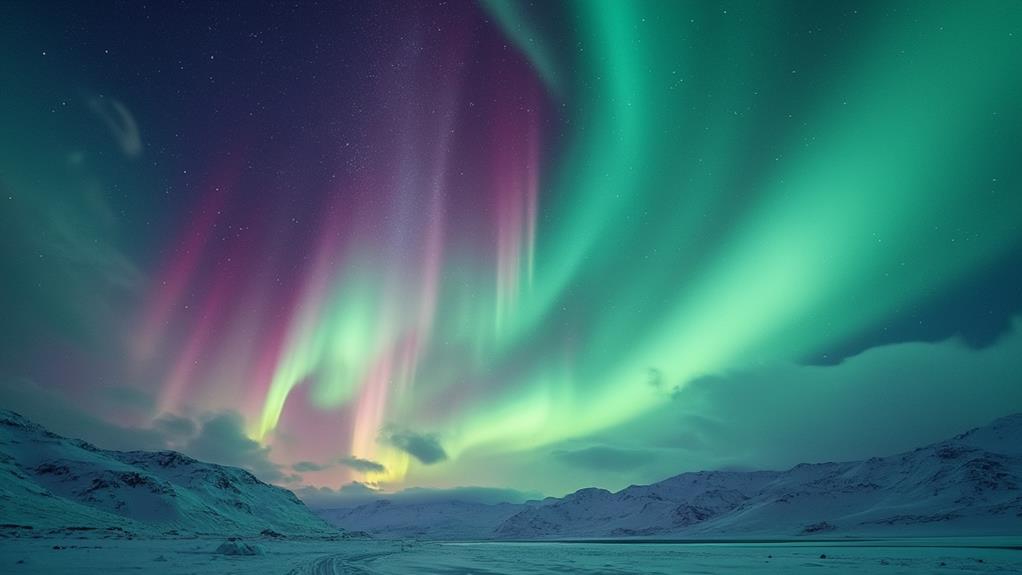
Understanding the formation and characteristics of the aurora borealis can greatly enhance your appreciation of this natural phenomenon. The aurora occurs when energized solar particles, primarily electrons, collide with atoms in Earth's upper atmosphere, at altitudes ranging from 97 to 1,000 km (60-620 miles). These particles are directed towards the poles by Earth's magnetic fields, primarily during solar storms, resulting in the stunning auroral emissions.
The colors of the aurora are predominantly green and red. Green is emitted by oxygen at altitudes of 100-150 km, while red appears at higher altitudes of 200-250 km. The interaction of these particles with atmospheric gases produces the varying colors and intensities observed.
Auroras display a fascinating array of shapes and patterns, including:
- Arcs: Discrete curves stretching across the sky.
- Curtains: Billowing, waving light formations.
- Rays: Long, radiant beams piercing the night sky.
- Dynamic Changes: Rapid shifts in shapes and colors during an auroral event.
The intensity and variation in aurora displays depend on the energy transferred during collisions and the composition of atmospheric gases. This breathtaking phenomenon is a direct result of the interplay between solar particles and Earth's atmospheric conditions.
Viewing Tips
Catching a glimpse of the aurora borealis requires careful planning and some luck. To improve your chances of witnessing these magnificent northern lights, plan your aurora hunting trip between September and April. The optimal viewing time is typically from 9 p.m. to 3 a.m. in prime locations like Fairbanks, Alaska, and Yellowknife, Canada.
Dress warmly in layers, as you'll be outside in cold temperatures for extended periods. This ensures you stay comfortable while waiting for the aurora to appear. Use the Aurora mobile app and monitor aurora forecasts from reliable sources such as the University of Alaska Fairbanks and NOAA. These tools keep you informed about solar activity and potential solar storms, which can significantly impact aurora visibility.
Choose locations far from city lights to minimize light pollution. Ensure the skies are clear and dark enough for the best visibility of the aurora's various shapes and patterns. Be patient; auroras can vary in intensity and may appear suddenly, with displays lasting from minutes to hours. By following these viewing tips, you'll significantly increase your chances of witnessing the awe-inspiring northern lights.

